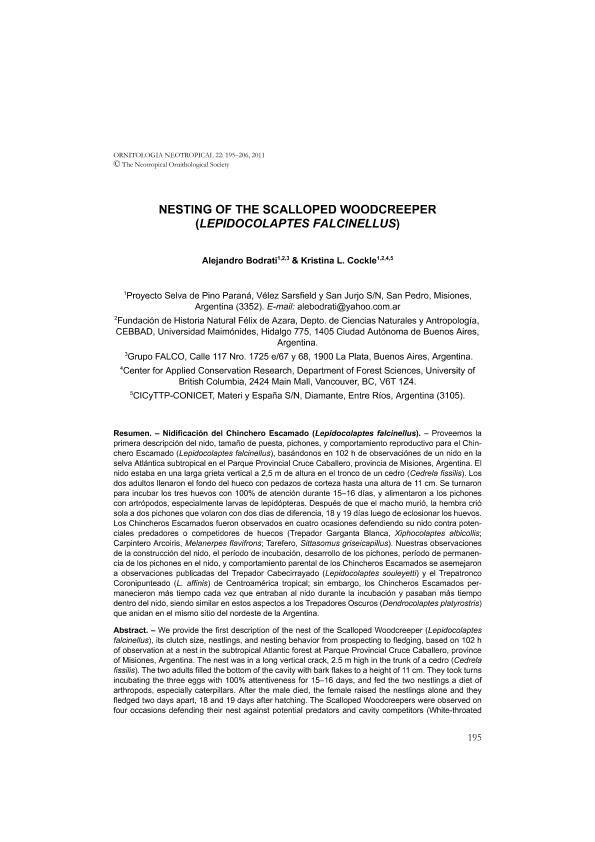Mostrar el registro sencillo del ítem
dc.contributor.author
Bodrati, Alejandro
dc.contributor.author
Cockle, Kristina Louise

dc.date.available
2019-07-26T20:39:14Z
dc.date.issued
2011-06
dc.identifier.citation
Bodrati, Alejandro; Cockle, Kristina Louise; Nesting of the Scalloped Woodcreeper (Lepidocolaptes falcinellus); Neotropical Ornithological Society; Ornitología Neotropical; 22; 6-2011; 195-206
dc.identifier.issn
1075-4377
dc.identifier.uri
http://hdl.handle.net/11336/80420
dc.description.abstract
We provide the first description of the nest of the Scalloped Woodcreeper (Lepidocolaptes falcinellus), its clutch size, nestlings, and nesting behavior from prospecting to fledging, based on 102 h of observation at a nest in the subtropical Atlantic forest at Parque Provincial Cruce Caballero, province of Misiones, Argentina. The nest was in a long vertical crack, 2.5 m high in the trunk of a cedro (Cedrela fissilis). The two adults filled the bottom of the cavity with bark flakes to a height of 11 cm. They took turns incubating the three eggs with 100% attentiveness for 15 to 16 days, and fed the two nestlings a diet of arthropods, especially caterpillars. After the male died, the female raised the nestlings alone and they fledged two days apart, 18 and 19 days after hatching. The Scalloped Woodcreepers were observed on four occasions defending their nest against potential predators and cavity competitors (White-throated Woodcreeper, Xiphocolaptes albicollis; Yellow-fronted Woodpecker, Melanerpes flavifrons; Olivaceous Woodcreeper, Sittasomus griseicapillus). Our observations of nest construction, incubation period, nestling development, nestling period, and parental behavior for Scalloped Woodcreepers were similar to published observations for Streak-headed Woodcreepers (Lepidocolaptes souleyetti) and Spot-crowned Woodcreepers (L. affinis) of tropical Central America; however, Scalloped Woodcreepers had longer bouts on the nest and higher nest-attentiveness during incubation, and in these characteristics were similar to Planalto Woodcreepers (Dendrocolaptes platyrostris) that breed at the same site in northeastern Argentina.
dc.description.abstract
We provide the first description of the nest of the Scalloped Woodcreeper (Lepidocolaptes falcinellus), its clutch size, nestlings, and nesting behavior from prospecting to fledging, based on 102 h of observation at a nest in the subtropical Atlantic forest at Parque Provincial Cruce Caballero, province of Misiones, Argentina. The nest was in a long vertical crack, 2.5 m high in the trunk of a cedro (Cedrela fissilis). The two adults filled the bottom of the cavity with bark flakes to a height of 11 cm. They took turns incubating the three eggs with 100% attentiveness for 15–16 days, and fed the two nestlings a diet of arthropods, especially caterpillars. After the male died, the female raised the nestlings alone and they fledged two days apart, 18 and 19 days after hatching. The Scalloped Woodcreepers were observed on four occasions defending their nest against potential predators and cavity competitors (White-throated Woodcreeper, Xiphocolaptes albicollis; Yellow-fronted Woodpecker, Melanerpes flavifrons; Olivaceous Woodcreeper, Sittasomus griseicapillus). Our observations of nest construction, incubation period, nestling development, nestling period, and parental behavior for Scalloped Woodcreepers were similar to published observations for Streak-headed Woodcreepers (Lepidocolaptes souleyetti) and Spot-crowned Woodcreepers (L. affinis) of tropical Central America; however, Scalloped Woodcreepers had longer bouts on the nest and higher nest-attentiveness during incubation, and in these characteristics were similar to Planalto Woodcreepers (Dendrocolaptes platyrostris) that breed at the same site in northeastern Argentina.
dc.format
application/pdf
dc.language.iso
eng
dc.publisher
Neotropical Ornithological Society

dc.rights
info:eu-repo/semantics/openAccess
dc.rights.uri
https://creativecommons.org/licenses/by-nc-sa/2.5/ar/
dc.subject
Scalloped Woodcreeper
dc.subject
Lepidocolaptes Falcinellus
dc.subject
Atlantic Forest
dc.subject
Nest Defense
dc.subject
Nestlings
dc.subject
Parental Care
dc.subject.classification
Zoología, Ornitología, Entomología, Etología

dc.subject.classification
Ciencias Biológicas

dc.subject.classification
CIENCIAS NATURALES Y EXACTAS

dc.title
Nesting of the Scalloped Woodcreeper (Lepidocolaptes falcinellus)
dc.title
Nidificación del Chinchero Escamado (Lepidocolaptes falcinellus)
dc.type
info:eu-repo/semantics/article
dc.type
info:ar-repo/semantics/artículo
dc.type
info:eu-repo/semantics/publishedVersion
dc.date.updated
2019-07-22T13:14:16Z
dc.journal.volume
22
dc.journal.pagination
195-206
dc.journal.pais
Canadá

dc.description.fil
Fil: Bodrati, Alejandro. Proyecto Selva de Pino Paraná; Argentina. Fundación de Historia Natural Félix de Azara; Argentina. Grupo FALCO; Argentina
dc.description.fil
Fil: Cockle, Kristina Louise. Fundación de Historia Natural Félix de Azara; Argentina. Proyecto Selva de Pino Paraná; Argentina. Provincia de Entre Ríos. Centro de Investigaciones Científicas y Transferencia de Tecnología a la Producción. Universidad Autónoma de Entre Ríos. Centro de Investigaciones Científicas y Transferencia de Tecnología a la Producción. Consejo Nacional de Investigaciones Científicas y Técnicas. Centro Científico Tecnológico Conicet - Santa Fe. Centro de Investigaciones Científicas y Transferencia de Tecnología a la Producción; Argentina. University of British Columbia; Canadá
dc.journal.title
Ornitología Neotropical

dc.relation.alternativeid
info:eu-repo/semantics/altIdentifier/url/https://sora.unm.edu/node/133227
Archivos asociados
